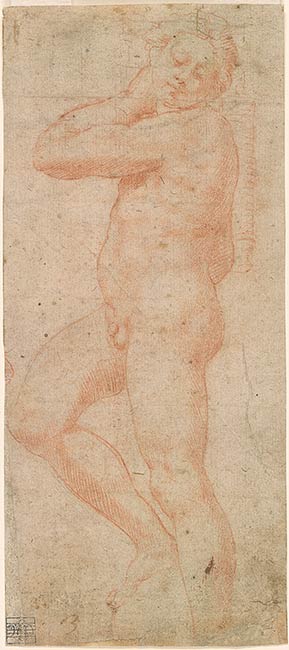

This drawing is a copy after a marble sculpture by Michelangelo, now in the Museo Nazionale del Bargello, Florence. The copyist represented the head turned further to the left than Michelangelo’s work. A Medici inventory of 1553 of the collection of Duke Cosimo referred to the sculpture as a “David”, but it more likely represents the Greek God, Apollo, drawing an arrow from his quiver. Charles de Tolnay, following A. E. Popp, argued that Michelangelo began work on the sculpture in the winter of 1525-26.1 Although this suggestion was followed by some other scholars, a date of late 1530 to 1531 is more likely, as argued by Konrad Oberhuber and Dean Walker, and by Martin Weinberger.2
Until recently, following Tolnay, the drawing has been considered to be by Rosso Fiorentino. This attribution, however, poses problems of dating if a date of around 1530-31 for Michelangelo’s sculpture is accepted, since Rosso could only have been in Florence after his flight from Rome in mid-1527 until spring 1530, when he departed from Borgo San Sepolcro for Venice. Moreover, the drawing would have had to have been executed before October 1529, because from that date until August 1530, the Siege of Florence prevented access to the city.
In 1991, Philippe Costamagna suggested instead an attribution to Francesco Salviati.3 Independently, Paul Joannides, in a letter dated 14 April 1997 and in subsequent publications, also attributed the drawing to Salviati, citing the similarity of its style to that of several drawn copies in red chalk after Michelangelo in the British Museum and in the Uffizi.4 All the drawings by – or attributed to – Salviati, are of comparable size and show the influence of Rosso’s draftsmanship. Two of these drawings bear the same numbering as the Morgan sheet.5 Joannides dates the entire group to about 1533.
Footnotes:
- Popp 1922, 141-42; Tolnay 1948, 3: 182;
- Washington and New York, 1973-74, 32-33, no. 25; Weinberger 1967, 348.
- Costamagna 1991, 61 note 19.
- British Museum, inv. 1946-7-13-369, numbered “4”; 1946-7-13-370, numbered “8”.
- British Museum, London, inv. 1946-7-13-369; 1946-7-13-370; 1946-7-13-371; Uffizi, Florence, inv. 253 F; 594 F. See Rome and Paris 1998, 55 note 3; Ames-Lewis and Joannides 2003, 71.
Watermark: none.
A copy after Michelangelo's David (Apollo) in the Museo Nazionate del Bargello, Florence.
Formerly attributed to Rosso Fiorentino.
Numbered at lower left, in pen and brown ink, "3".
Rosso Fiorentino, 1494-1540, Formerly attributed to.
Michelangelo Buonarroti, 1475-1564, after.
Scholz, János, former owner.
Selected references: Tolnay 1948, 3: 96, 182 (as Rosso); Oakland and Berkeley 1961, no. 73 (as Rosso); Cambridge 1962, no. 30 (as Rosso); Milwaukee 1964, no. 34 (as Rosso); Notre Dame and Binghamton 1970, 74-75, no. D8 (as Rosso); Pope-Hennessy 1970, 324-25; Providence 1973, 56, no. 61 (as Rosso); Washington and New York, 1973-74, 32-33, no. 25, (as Rosso); Carroll 1976, 1: 158-61, 2: 258-62, no. D.22 (as Rosso); Darragon 1983, 42 (as Rosso); Washington 1987-88, 146-48, no. 49 (as Rosso); Fellows Report 1989, 374 (as Rosso); Costamagna 1991, 61, note 19 (as Salviati); Joannides, in Rome and Paris 1998, 55, note 3 (as Salviati); Rosenberg 2000, 246-47, no. NZ398 (as Rosso); Joannides, in Ames-Lewis and Joannides 2003, 71 (as Salviati); Minning 2010, 238 (as unknown artist).
Charles de Tolnay, Michelangelo: The Medici Chapel, III, Princeton, 1948, 182, fig. 272.
Eugene A. Carroll, "Some Drawings by Rosso Fiorentino," Burlington Magazine, ciii, 1961, 453, no. 28.
Eugene A. Carroll, The Drawings of Rosso Fiorentino, New York, 1976, I, 158-61, II, 258-62, fig. 76.
Rosso Fiorentino: Drawings, Prints, and Decorative Arts, exh. cat. by Eugene A. Carroll, National Gallery of Art, Washington, D.C., 1987-88, no. 49, repr.
Twenty-first report to the Fellows of the Pierpont Morgan Library, 1984-1986 / edited by Charles Ryskamp. New York : The Library, 1989, p. 374-375.
